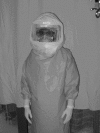Elective and emergency surgery in patients with severe acute respiratory syndrome (SARS)
- PMID: 15757044
- PMCID: PMC3211568
Elective and emergency surgery in patients with severe acute respiratory syndrome (SARS)
Figures
References
-
- Centers for Disease Control and Prevention (CDC). Interim domestic guidance on the use of respirators to prevent transmission of SARS. Atlanta (GA): CDC; 2003. Available: www.cdc.gov/ncidod/sars/pdf/respirators-sars.pdf (accessed 2004 Nov 8).
-
- Ofner M, Lem M, Sarwal S, Vearncombe M, Simor A. Cluster of severe acute respiratory syndrome cases among protected health care workers — Toronto, April 2003. Can Commun Dis Rep 2003;29(11):93-7. - PubMed
-
- Centers for Disease Control and Prevention. Preliminary clinical description of severe acute respiratory syndrome. JAMA 2003;289(15):1920-1. - PubMed
Publication types
MeSH terms
LinkOut - more resources
Full Text Sources
Miscellaneous


